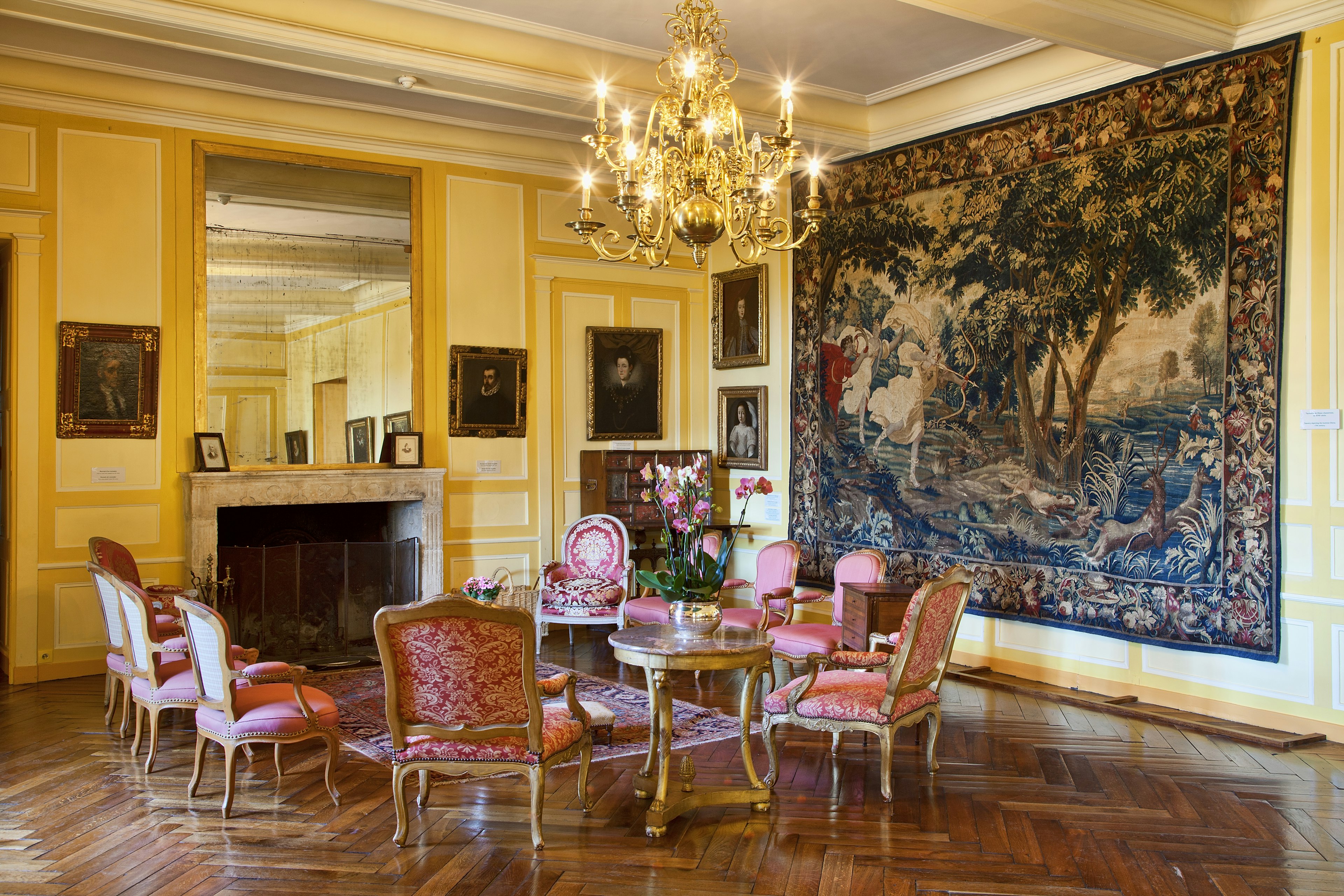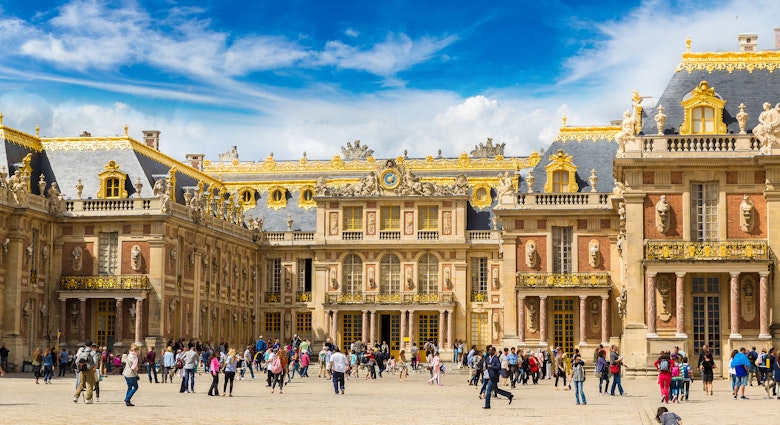
Sep 21, 2022 • 10 min read

Aug 16, 2022 • 9 min read

It may involve a steep climb to reach it but the views from Château de Montségur are worth the effort © Martin Silva Cosentino / Getty Images
There was a time, long, long ago, when the French royalty and nobility collected châteaux the way others collect stamps. Everyone wanted a piece of the palace pie it seemed and as a result, France is sprinkled with some 40,000 châteaux, spanning epochs and flaunting the historic clout. It’s an artistic sensibility and love of great, beautiful things that is so very French.
But not all châteaux are created equal: from manors to mighty crag-clutching forts in the Pyrenees, castles laid to romantic ruin to the exquisite necklace of turreted Renaissance palaces strung along the Loire Valley, you’ll find that some grip you with their looks and others with their backdrops and bloody history. These are our eight absolute favorite castles in France.
You can almost hear the stampeding hooves, crusading battle cries and clank of armor as you peer up at the great fist of rock punching above the wooded valley with the ruined fortress clinging to its top. Set against the cinematic backdrop of the French Pyrenees, in sun-scorched southern France’s Vallée de l’Ariège, Château de Montségur is the westernmost of the string of Cathar castles reaching across into Languedoc.
A medieval religious sect, the Cathars were in many ways quite ahead of their time – they were strict vegans who wanted equality, rejected the Catholic doctrine as immoral and believed in reincarnation. One thing is for sure: they knew how to build a good castle, even though it was here that they suffered their heaviest defeat in 1242 when the castle fell after an intense nine-month siege. Local legend has it that the Holy Grail was smuggled out of the castle to safety just before they were defeated.
It’s a stiff 20-minute climb up from the village of Montségur. Avoid the midday sun and bring plenty of water.

Even Walt Disney couldn’t have dreamt up a château more sensational than Unesco-listed Château de Chambord, deep in the central Loire Valley, an hour’s drive east of Tours. Imagine the most perfect French Renaissance palace built on the scale of the Taj Mahal. Of all the ludicrously romantic Renaissance chateaux in the drowsy, river-woven Loire, this one has the fairy-tale edge, with its harmonious symmetry, riot of silver witch-hat turrets, cupolas and domes, immaculately landscaped formal gardens, and wooded park home to stags, mouflon and wild boar.
The showpiece of the Loire châteaux, the palace is incredibly grand, but no one ever lived in it. François I started it as a weekend hunting retreat in 1519 but plans mushroomed and the palace quickly went off the charts in terms of budget and scale: 426 rooms, 282 fireplaces and 77 staircases no less. After three decades and immeasurable expense in the making, François deemed his new pad "too drafty" and stayed here for just 72 days during his 32-year reign.
Make a day of it, as there’s loads to see, including 18th-century kitchens, lavish royal bedchambers and the extraordinary double-helix staircase – allegedly designed by Leonardo da Vinci to stop the king’s wife from running into his mistress. Grab a HistoPad for a digital romp around the castle, with an interactive guide, maps and a treasure hunt for kids.
As if the château’s proportions weren’t stately enough, come in the morning or late afternoon and you’ll see it magnified as it checks its reflection in the still, mirror-like waters of the Cosson Canal.
Mountains rise sheer and rugged like natural ramparts above this knockout of a triple-towered castle in Ariège in the eastern French Pyrenees, midway between Toulouse and the Spanish border. You’ll pinch yourself when you clap your eyes on this fantasy fortress, perched eyrie-like atop a crag. With its riot of turrets, towers and crenellations, this medieval beauty of a Cathar castle was the final stronghold of the powerful ruling Comtes de Foix. From the 16th century onwards, its fate took a darker turn as it was used as a jail.
The real magic comes as you approach on the cobbled track from the old town, While the castle’s bare interior is something of an anti-climax, the battlements command astonishing views of the Pyrenees and the lushly wooded peaks of the Vallée de l'Ariège. Linger in the valley to explore rivers, caverns and waterfall-splashed canyons.

Reclining on the northern shore of its glittering turquoise lake and peering dreamily up to the French Alps, Annecy has a chilled southern vibe you mightn’t expect in an Haute-Savoie town just an hour’s over-the-mountain drive west of ski central Chamonix.
And it also has a rather fabulous château: a perfect chesspiece castle of ochre-stone towers and terracotta turrets that presides over the jumbled rooftops and web of emerald canals that form the Vieille Ville (Old Town). A fine example of a medieval fort, the château was the stomping ground of the counts of Geneva during the 13th and 14th centuries, a military barracks in the 1940s, and was classified as a historical monument in the 1950s.
Visit the museum for a shot of culture in the form of regional art, medieval sculpture, Savoyard furniture, Alpine landscape painting and contemporary art. The views are quite something, stretching across Annecy and its lake all the way to the peaks of the Parc Naturel Régional du Massif des Bauges.
If you prefer proper mist-swirled forts to fancy palaces and brooding ruins to bombastic interiors, craggy, cliff-hugging, seemingly impregnable Château Gaillard in Normandy will have you in raptures. An hour south of Rouen, this heart-stopper of a romantic ruin towers above the quaint village of Les Andelys on a particularly scenic bend in the Seine River.
Hacked straight out of the rock, the castle looks like the mad genius of a bold and ambitious king, and indeed it was built by Richard the Lionheart in the 12th century to guard the Seine River approach to Normandy and secure the western border of English territory until Henry IV ordered its destruction in 1603 (it first fell in 1204). When it was completed, word has it the king declared it gaillard, which can be translated as "saucy", "strapping" or "defiant" (take your pick).
The magnificent bastion certainly impresses with its inner bailey, upper court and dungeons, but it's the views from the château grounds that stay with you, especially as sunset golds render the castle to silhouette and the Seine twists away into the watercolor distance.

Following the meandering Loire River west of Tours brings you to this resplendent château. You might do a double take when you see its stately but mismatched appearance – all harmonious Renaissance beauty but for the keep of the medieval feudal fortress that was otherwise razed to the ground in 1532. The donjon pays homage to the place where Henry II of England (Henry Plantagenet) admitted defeat to King Philip Augustus of France, signing the La Paix de Colombiers treaty two days before he died.
Unlike many, this palace wasn’t built for royalty but for Jean Le Breton, who served François I as finance minister and ambassador to Italy. You’ll see his passion for art and far-flung lands in the Oriental drawing room, with its gilded Moorish ceiling, and gallery of Spanish and Flemish art.
Le Breton was fond of Italian Renaissance gardening and it shows. The château’s landscaped gardens shine with fountains, cascading flowers and vines, impressive topiary and box hedges. Exploring, you’ll come across the Jardin d'Eau (Water Garden), the hornbeam Labyrinthe (Maze) and the 16th-century-style Jardin des Simples (Kitchen Garden), where cabbages, leeks and carrots are laid out to create nine geometrical, color-coordinated squares. Come from April to October to see the gardens in full bud and bloom.
Don’t leave without getting a view of the Loire and Cher Rivers from the top of the keep and three belvédères (hillside panoramic viewpoints).
If you were Louis XIV back in the 17th century, with all the riches you could desire, France’s future at your fingertips, a court at your beck and call and an ego as big as an elephant, what better way to exert your influence than by building Versailles – a palace to outpomp them all, which projected the might of the French monarchy when it was at its most powerful. And it was built on a scale that beggars belief (700 rooms, 2153 windows, 67 staircases, paintings laid 11km/6.8 miles end to end, 5000 objets d’art – you get the picture).
Sparing no expense, the Roi Soleil (Sun King) enlisted the most ingenious artisans of the age: architect Louis Le Vau, painter and interior designer Charles Le Brun and landscape gardener André Le Nôtre, who together with 30,000 workers toiled away to decorate every last inch of the palace with gold leaf, frescoes, marble, intricate wood carvings and scenes drawing richly on Greek and Roman mythology – swiftly and efficiently draining the country's coffers as they did so.
And my, my is the result magnificent. Not without reason do 10 million people flock from Paris and far beyond to the leafy, bourgeois suburb of Versailles to see the palace par excellence each year. Prepare to be blown away by the Grands Appartements du Roi et de la Reine (King’s and Queen’s State Apartments), with rooms devoted to Hercules, Venus, Diana, Mars and Mercury, and the staggeringly opulent Galerie des Glaces (Hall of Mirrors), a 75m-long (246ft) ballroom with 17 huge mirrors on one side and, on the other, an equal number of windows looking out over the gardens and the setting sun.
The formal gardens are every bit as sublime as the palace itself, with their geometrically aligned terraces, dancing fountains, flower beds, mythological sculptures and Grand Canal, oriented to reflect the sun that Louis XIV worshipped so ardently.
Truth be told, Versailles can seem intimidating to first-timers, so planning is everything. Book tickets online to skip the queue, take into account opening times (it’s closed on Monday and at its busiest on Tuesday, Saturday and Sunday), arrive early morning and download the app for an audio guide and map of the estate. To see off-limits areas of the palace, pre-book a guided tour.
Swirling in Renaissance romance, 16th-century Château d’Azay-le-Rideau, a short hop south of Tours, is quite possibly the Loire Valley château of your wildest dreams – a graceful, perfectly proportioned vision of creamy stone, steep slate roofs and silver turrets, vainly admiring its reflection in the waters of its moat. On an island in the middle of the Indre River, it’s so darned lovely you half expect a Disney princess to come wafting out of the door any second.
Your spin of the château will undoubtedly take in the splendid Italian-style loggia staircase overlooking the central courtyard, embellished with salamanders and ermines – the emblems used by François I and Queen Claude. The largely 19th-century interiors were fashioned by Marquis Charles de Biencourt (who bought the château after the Revolution) and his heirs. Take time to wander the English-style gardens and the Jardin des Secrets, planted with a fantasy of heritage flowers and vegetables.

Art and Culture
Marie Antoinette’s rooms at Versailles will reopen in June. Here's what you can see insideJun 1, 2023 • 3 min read

Sep 21, 2022 • 10 min read





Oct 24, 2024 • 13 min read


